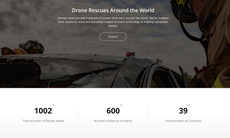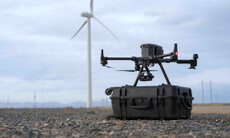
When it comes to automation in the construction industry, drones might not be the first thing that comes to mind. After all, this is an industry that still relies a great deal on skilled labor with problem-solving skills that seemingly fall beyond the reach of robotic replacements. Nonetheless, Unmanned Aerial Vehicles are already being used to help assess buildings more safely and efficiently at construction sites through the use of their aerial imaging capabilities.
Visual inspection of large construction sites used to require hiring a helicopter and a photographer to fly over and take pictures. For smaller sites, construction companies would have to set up scaffolding or even use a crane to inspect rooftops, high-up equipment, and tall buildings under dangerous conditions. In the United States, Danis Building Construction Co. came up with a safer and more flexible way to assess buildings by modifying a DJI Phantom 2 Vision+ as a tool to take pictures from the air.
“There are a lot of ways [drones] could help us do things more safely,” said Rob Mauro, MEP coordinator for Danis. “Whether it’s surveying an unsound roof or some kind of situation where we need to set up scaffolding or where there’s risk involved, this could help.”
—Dayton construction firm buys drone for safer surveying (Dayton Business Journal)
Across the Pacific, an ageing population and a shortfall in young, fit workers has led Japanese construction companies to go even further to incorporate the latest information and communication technologies to help build future infrastructure. These smart construction platforms connect human workers, machinery, and drones to the cloud, improving efficiency overall and artificial intelligence-assisted control.
“The value of drones in construction, at least for the time being, is more or less tied to their ability to venture where humans and heavy machinery cannot. This dictates that the vehicles remain small, agile and with minimal payload, zipping around with onboard high-res cameras and relaying progress shots and aerial surveys to construction teams on the ground.”
—Drones are already incredibly efficient at aerial mapping on building sites (Gizmag)
Beyond construction site inspection and aerial mapping, flying robots may even be used to construct actual buildings without any assistance from a human hand. In Switzerland, a fleet of quadcopters was programmed to interact, lift, transport, and assemble a 6-meter tower by neatly laying bricks based on commands received wirelessly from a local control room.
“One by one, a fleet of flying robots dropped the pieces into place, guided by mathematical algorithms that took digital design data and translated it into flight paths.”
—Flying robots to build a 6-meter tower (Gizmag)
From the U.S. to Japan and everywhere in between, drones are helping construction companies save valuable time and money by delivering payloads of precise data to survey construction sites more reliably, all the while negating the need for costly safety equipment and heavy machinery. Besides aerial mapping and site monitoring applications, flying robots, with future advances in artificial intelligence, may even become master builders in their own right.


